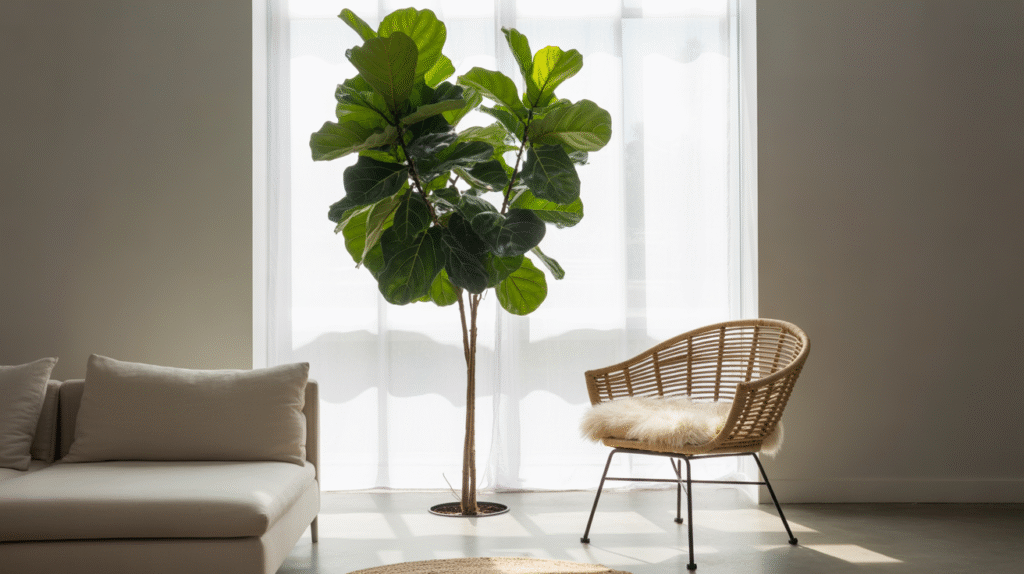Your living room is the heart of your home—the place where you relax, entertain guests, and spend quality time with family. But imagine walking into a living room that doesn’t just look beautiful, but also feels fresher, calmer, and more alive. That’s the magic of indoor plants for living room décor.
From air-purifying plants to statement floor plants, the right greenery can completely transform your space. Indoor plants bring nature indoors, boost mood, reduce stress, and improve indoor air quality—all while adding a touch of elegance to your interior design.
In this guide, we’ll explore the best indoor plants for living rooms, how to style them, tips for care, and why they’re more than just pretty décor pieces. Whether you’re a beginner or a seasoned plant parent, you’ll find plenty of ideas to turn your living room into a lush, green retreat.
Why Add Indoor Plants to Your Living Room?
1. Natural Air Purifiers
NASA’s Clean Air Study revealed that many indoor plants can remove toxins like benzene, formaldehyde, and carbon monoxide from the air.
2. Mood-Boosting Benefits
Greenery has a calming effect, reduces stress, and improves concentration—making your living room a healthier environment.
3. Interior Design Statement
Large leafy plants or chic tabletop greenery can instantly elevate your living room décor.
4. Humidity Regulation
Plants release moisture into the air, helping balance dry indoor environments.
5. A Welcoming Atmosphere
Nothing makes a home feel cozier and more inviting than well-placed plants.
Best Indoor Plants for Living Rooms
Here are some of the top indoor plants that thrive in living rooms and add both style and health benefits.
1. Fiddle Leaf Fig (Ficus lyrata)
- Why it’s perfect: A tall, dramatic plant with large glossy leaves—ideal for corners or beside sofas.
- Care tips: Needs bright, indirect light and moderate watering.
- Bonus: Creates a bold focal point in modern interiors.
2. Monstera Deliciosa (Swiss Cheese Plant)
- Why it’s perfect: Iconic split leaves that bring tropical vibes to your space.
- Care tips: Thrives in bright, indirect sunlight; water weekly.
- Bonus: Very popular for Instagram-worthy décor.
3. Snake Plant (Sansevieria)
- Why it’s perfect: Hardy, low-maintenance, and great for purifying air.
- Care tips: Tolerates low light and infrequent watering.
- Bonus: Its upright leaves add vertical elegance.
4. Rubber Plant (Ficus elastica)
- Why it’s perfect: Glossy, dark-green leaves add sophistication.
- Care tips: Loves indirect light and moist (but not soggy) soil.
- Bonus: Excellent for minimalist or modern living rooms.
5. Areca Palm (Dypsis lutescens)
- Why it’s perfect: Feathery fronds add a tropical, airy look.
- Care tips: Prefers bright, indirect sunlight and regular watering.
- Bonus: Acts as a natural humidifier.
6. ZZ Plant (Zamioculcas zamiifolia)
- Why it’s perfect: Virtually indestructible—great for beginners.
- Care tips: Survives in low light and needs minimal water.
- Bonus: Shiny leaves add elegance to shelves or side tables.
7. Peace Lily (Spathiphyllum)
- Why it’s perfect: Elegant white flowers and lush green foliage.
- Care tips: Thrives in medium to low light; keep soil moist.
- Bonus: Known for removing indoor toxins.
8. Pothos (Epipremnum aureum)
- Why it’s perfect: Beautiful trailing vines—perfect for shelves or hanging planters.
- Care tips: Tolerates low light; water when soil is dry.
- Bonus: Easy to propagate for more greenery.
9. Bird of Paradise (Strelitzia reginae)
- Why it’s perfect: Large, banana-like leaves make a stunning statement.
- Care tips: Needs bright, direct sunlight and consistent watering.
- Bonus: Adds a luxurious, tropical flair.
10. Ferns (Boston Fern, Maidenhair Fern)
- Why they’re perfect: Soft, feathery foliage that looks lush and elegant.
- Care tips: Require high humidity and indirect light.
- Bonus: Excellent for adding texture and greenery to corners.
How to Style Indoor Plants in Your Living Room
Floor Plants for Corners
Tall plants like Fiddle Leaf Fig, Bird of Paradise, or Areca Palm make dramatic corner pieces.
Tabletop & Shelf Plants
Small plants such as Peace Lily, ZZ Plant, or Succulents look great on coffee tables, side tables, or shelves.
Hanging Plants
Trailing plants like Pothos or English Ivy can hang from ceiling planters or wall hooks.
Plant Groupings
Cluster different plants of varying heights for a layered, natural look.
Decorative Pots
Choose pots that match your interior style—ceramic, woven baskets, or modern minimalist designs.
How to Care for Indoor Living Room Plants
Watering Tips
- Check soil moisture before watering.
- Overwatering is the most common mistake—avoid soggy soil.
Lighting Tips
- Place sun-loving plants near windows.
- Use grow lights for darker living rooms.
Humidity & Temperature
- Keep plants away from heaters or AC vents.
- Mist humidity-loving plants like ferns and palms.
Pruning & Cleaning
- Remove yellowing leaves.
- Wipe dust off leaves regularly to keep them healthy.
Repotting
- Repot every 1–2 years to give roots room to grow.
Benefits of Indoor Plants in Living Rooms
- Healthier Air Quality – Filters toxins and boosts oxygen.
- Enhanced Mood & Relaxation – Brings nature indoors for a calming vibe.
- Improved Home Aesthetics – Adds sophistication, color, and vibrancy.
- Stress Reduction – Greenery naturally reduces anxiety and stress.
- Welcoming Space – Creates a cozy, inviting atmosphere for guests.
Step-by-Step Guide to Adding Plants to Your Living Room
- Assess Your Space – Identify lighting, corners, and décor style.
- Choose Easy Plants First – Start with Snake Plant, ZZ Plant, or Pothos.
- Pick Stylish Pots – Match pots with your living room theme.
- Add a Mix of Sizes – Combine tall floor plants with small tabletop ones.
- Create a Care Routine – Water weekly, wipe leaves, and prune when needed.
Common Problems & Quick Fixes
- Yellow leaves → Overwatering.
- Brown leaf tips → Low humidity.
- Drooping leaves → Lack of light or irregular watering.
- Pests → Spray with neem oil or wipe leaves with soapy water.
FAQs About Indoor Plants for Living Room
1. Which indoor plant is best for the living room?
Fiddle Leaf Fig, Monstera, and Snake Plant are some of the best choices for both beauty and air-purifying qualities.
2. Do indoor plants really clean the air?
Yes, plants like Peace Lily, Areca Palm, and Rubber Plant filter toxins and improve air quality.
3. How many plants should I have in my living room?
It depends on space—3–5 medium plants are ideal for most living rooms.
4. Can indoor plants survive in low light?
Yes, plants like Snake Plant, ZZ Plant, and Pothos thrive in low-light conditions.
5. How do I style plants in a small living room?
Use hanging plants, wall-mounted shelves, and compact tabletop plants to save space.
Conclusion
Adding indoor plants to your living room is more than just a design choice—it’s an investment in health, relaxation, and beauty. From the bold Fiddle Leaf Fig to the low-maintenance Snake Plant, there’s a perfect plant for every home and lifestyle.
Start small, experiment with different styles, and soon your living room will become a lush, refreshing sanctuary.
🌿 Want more plant inspiration? Visit Green Plant Zone for expert guides, care tips, and the best plant ideas to make your home greener and healthier.

Hi, I’m the creator of Green Plant Zone, a space dedicated to plant lovers. I share tips on indoor and outdoor gardening, plant care guides, and eco-friendly living. My mission is to help you grow healthier, happier plants and bring more greenery into everyday life.
